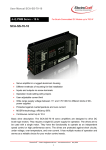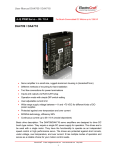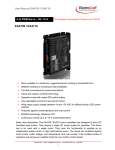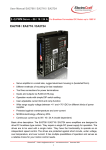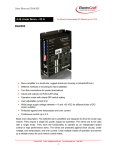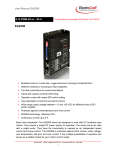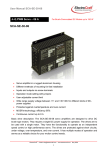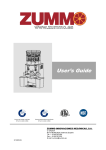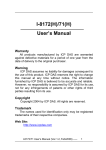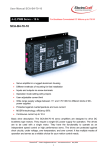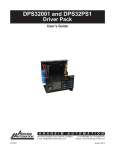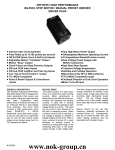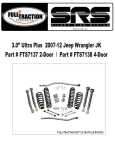Download User Manual - ElectroCraft
Transcript
User Manual SA4505 / SA4510 4–Q PWM Servo – 05 / 10 A For Stepper Motors up to 480 W SA4505 / SA4510 • Stepper motor driver in a small size, rugged aluminium housing in (bookshelf form) • Different methods of mounting for fast installation • Tool free connections for power terminations • Opto-coupler inputs and outputs via RJ45-CAT5 plug • Operation mode with simple DIP switch setting • User adjustable current limit and micro-stepping • Wide range supply voltage between +11 and +48 VDC for different kinds of DCpower supplies • Protected against over temperature and over current • Integrated oscillator and adjustable fallback • Continuous current up to 5 / 10 A (model dependent) Basic drive description: The SA4505/SA4510 stepper motor drivers are designed to drive stepper motors in bipolar mode. They require a single DC power supply for operation. The drives are to be used with a single 2-phase stepper motor. They have the functionality to operate as an independent speed control. The drives are protected against under voltage, over temperature, and over current. It has multiple modes of operation and serves as a reliable choice for your motion control needs. ElectroCraft® E-Mail: [email protected] 1 www.electrocraft.com November 2009 User Manual SA4505 / SA4510 Table of Contents 1. Safety & Installation ......................................................................... 3 2. Specifications: .................................................................................. 4 3. Block Diagram................................................................................... 6 4. Wiring................................................................................................. 9 5. Explanation of Terminals, Dip Switches, & Potentiometer ......... 16 6. Stepping-Modes .............................................................................. 19 7. Current Selection ............................................................................ 23 8. Fallback ........................................................................................... 24 9. Internal Oscillator ........................................................................... 25 10. Description of Inputs and Outputs ................................................ 26 11. Glossary .......................................................................................... 30 12. Basic Troubleshooting ................................................................... 36 13. Heat Dissipation.............................................................................. 37 14. Accessories & Options .................................................................. 39 15. Warranties & Disclaimers .............................................................. 40 16. Dimensions ..................................................................................... 41 17. Mounting Din rail adapter .............................................................. 41 Used Symbols Indicates a warning or caution concerning operations that may lead to death or injury to persons, or damage to property if not performed correctly. In order to use the drive safely, always pay attention to these warnings. Indicates a clarification of an operation, or contains additional explanations, or operational requirements for a procedure. Reading these notes is much recommended. ElectroCraft® E-Mail: [email protected] 2 www.electrocraft.com November 2009 User Manual SA4505 / SA4510 1. Safety & Installation The SA4505/SA4510 requires installation by qualified personal which must pay attention to significant safety and other regulatory standards. They should be thoroughly familiar with the entire system before beginning installation. Before final operation of machine be sure to test hookup with motor disconnected from the load. Improper wiring could cause a “motor run away” condition, and cause serious injury or damage to the machine and personal. Before starting installation of the SA4505/SA4510, be sure that main power is disconnected. After powering the drive it should not be touched by hand or risk shock. Be care that in case of regeneration or in brake operation the energy recovery must be buffered by the power supply and / or a braking module. Ensure with electronically stabilized power supplies that protection circuit isn’t react. Don’t switch off the power supply while the motor is turning, in this case the drive could be destroyed by regeneration. We recommend connecting a capacitor of 1000 µF per each ampere output current close to power input, in parallel. Do not repair or open drives enclosure. Result would result in personal injury and would void all warranties. The SA4505/SA4510 comply with the European directive EN 61800-3 (1996). The followings points must followed: • A metal mounting plate with correct grounding is mandatory. • For installation purposes, tooth lock washers have to be used. • For most wiring schemes, only shielded cables are admissible, to suppress interference with other devices. Damaged items have to be replaced. • Provide for a large contact area between shields and mounting plate. • The motor has to be grounded. • The drive is an Electrostatic Sensitive Device (ESD). Electrostatic discharge needs to be avoided. NOTE: Certain applications may involve special requirements. Consult Factory! ElectroCraft® E-Mail: [email protected] 3 www.electrocraft.com November 2009 User Manual SA4505 / SA4510 2. 2.1 Specifications: Electrical Data Power Supply Voltage +11 to +48 VDC (Residual ripple <5 %) (The lower limit is monitored integrated undervoltage trip) by WARNING: Do not exceed 48V. Overvoltage will damage the drive. Auxiliary Voltage Input +5 to +24 VDC Supply voltage +Vopto for the optocouplers. Current max. 5 / 10 A (model dependent) Maximum Power (only achievable with additional heatsink & proper mounting, see accessories.) 240 / 480 W (model dependent) Fixed Off Time of Power Output Stage 20 µs Efficiency 95 % Induction Specification Not defined. (Refer chapter 11 - Inductance) Power connector The diameter must be suited for the connecting wires of the current load. The recommendation is 1,5 mm2 (AWG16), the minimum is 0,13 mm2 (AWG28). Maximum wire diameter with respect to the plug contact is 2,5 mm2 (AWG14). Strip the wire insulation of the cables on a length of 10 mm. For stranded wire, use end sleeves with the corresponding length. Wire ends have to be inserted into the contact, until they reach the stop. Signals For the cabling of the RJ45 plug, we recommended shielded CAT5 cables. The cables are available in different colours and lengths in the system accessories. ElectroCraft® E-Mail: [email protected] 4 www.electrocraft.com November 2009 User Manual SA4505 / SA4510 2.2 Mechanical Data Mechanical Dimensions L x W x H 120 x 85 x 27.5 mm Weight 200 / 220 g Mounting 2.3 2.4 M3 screws or Din Rail Mounting Ambient Conditions Operation Temperature -10 to +45 °C Storage Temperature -40 to +85 °C Humidity (Non Condensing) 20 % to 80 % RH Overtemperature Protection +80 °C Digital and Analog Inputs Optical; Ri = 1kOhm; max. 20 mA /Enable Optical; Ri = 1kOhm; max. 20 mA; shortest pulse repetition time = 4 µs /Step Optical; Ri = 1kOhm; max. 20 mA /Dir Analog +1… +5 VDC ; Resistance = 100 kOhm Spdext 2.5 Outputs Auxiliary Voltage Outputs +5V +5 V / 50 mA Optical; max. 20 mA Error 2.6 Control LEDs LED green Power Note: The LED is lit when the operating voltage is present and the undervoltage protection circuit has not been initiated. LED red Error The lamp is lit at overtemperature. It disables only after reset the Enable input. If the error condition persists (i.e. temperature still too high), this is immediately visible by the red LED. ElectroCraft® E-Mail: [email protected] 5 www.electrocraft.com November 2009 User Manual SA4505 / SA4510 3. Drive Overview 3.1 Block Diagram ElectroCraft® E-Mail: [email protected] 6 www.electrocraft.com November 2009 User Manual SA4505 / SA4510 3.2 Input & Output Schematics ElectroCraft® E-Mail: [email protected] 7 www.electrocraft.com November 2009 User Manual SA4505 / SA4510 3.3 Control Elements ElectroCraft® E-Mail: [email protected] 8 www.electrocraft.com November 2009 User Manual SA4505 / SA4510 4. Wiring According to the safety directives, a correct cable selection is mandatory. Regular inspection is advisable. Damaged, burned or kinked items have immediately to be exchanged. Power (Power ⊕ - Power GND) • Normally no shielding required. • When connecting several amplifiers to the same supply pack, use star point wiring. Motor Wiring (> 30 cm) • Only shielded cables are recommended. • Connect the shield to the ground lug of the servo amplifier. • A separate cable has to be used. • Choke modules are useful to reduce PWM-pulses. Analog Signal (Spdext) • In most cases no shielding required. This may be different for low level signals or in an environment with strong magnetic interference. • Connect the shield on either end of the cable. For 50/60 Hz interference, remove the shield on one side. Digital Signals (/Enable, /Step, /Dir, Error) • No shielding required but in ambient with higher electromagnetic disturbances shielded cable make be sense. To verify a trouble-free operation and the conformity to CE regulation, it makes only sense to test the system as a whole, with all components installed (motor, amplifier, supply pack, EMC filters cables etc.). Note: To improve the resistance to the noise immunity, always connect unused logical inputs to a fix potential (GND or +5V). Do not connect the CAT5 connectors to any network. ElectroCraft® E-Mail: [email protected] 9 www.electrocraft.com November 2009 User Manual SA4505 / SA4510 4.1 Minimum Wiring Setting of the drive: Operation Mode: Current Select: Fallback: Internal Oscillator: Fullstep; /Enable is controlled by switch. 5,0 / 10,0 A Not activated. Switched on, speed is set by the internal potentiometer. ElectroCraft® E-Mail: [email protected] 10 www.electrocraft.com November 2009 User Manual SA4505 / SA4510 4.2 Wiring Example I Setting of the drive: Operation Mode: Current Select: Fallback: Internal Oscillator: Microstepping 1/4; /Enable is controlled by switch. 2,0 / 4,0 A Not activated. Switched on, speed is set by the external potentiometer. ElectroCraft® E-Mail: [email protected] 11 www.electrocraft.com November 2009 User Manual SA4505 / SA4510 4.3 Wiring Example II Setting of the drive: Operation Mode: Current Select: Fallback: Internal Oscillator: Microstepping 1/16; /Enable, /Dir, /Step are controlled by external controller. 4,0 / 8,0 A Activated. At standstill the current is reduced to 60%. Switched off. The speed is set by the external controller. ElectroCraft® E-Mail: [email protected] 12 www.electrocraft.com November 2009 User Manual SA4505 / SA4510 4.4 Wiring Example III Setting of the drive: Operation Mode: Current Select: Microstepping 1/2; 1,0 / 2,0 A /Enable, /Dir, are set by switch. ElectroCraft® E-Mail: [email protected] 13 Fallback: Internal Oscillator: Not activated. Switched on at high frequency, speed is set by the internal potentiometer. www.electrocraft.com November 2009 User Manual SA4505 / SA4510 4.5 Wiring Example IV Setting of the drive: Operation Mode: Current Select: Microstepping 1/4; 3,0 / 6,0 A /Enable, /Dir, are set by switch. +V Opto is given from extern. ElectroCraft® E-Mail: [email protected] 14 Fallback: Internal Oscillator: Activated. At standstill the current is reduced to 60%. Switched off. The speed is set by the /Step input. www.electrocraft.com November 2009 User Manual SA4505 / SA4510 4.6 Motor Connections Bipolar 4 Leads Bipolar 6 Leads Series Bipolar 6 Leads 1 Winding Bipolar 6 Leads Parallel Bipolar 8 Leads Series Bipolar 8 Leads Parallel ElectroCraft® E-Mail: [email protected] 15 www.electrocraft.com November 2009 User Manual SA4505 / SA4510 5. Explanation of Terminals, Dip Switches, & Potentiometer 5.1 Terminals Terminal Label Description S1-1; S1-2 select stepping mode. S1-3 – S1-5 select the current. S1 S1-6 select the internal oscillator. S1-7 select the range of the internal oscillator. Pin 1 & 2 connect to power supply. X1 Pin 3 & 4 connect to motor phase A. Pin 5 & 6 connect to motor phase B. Pin 1 digital input /Step. Pin 2 digital input Dir. Pin 3 digital input /Enable. Pin 4 supply voltage opto-isolator. X2 Pin 5. voltage output +5 VDC. Pin 6 analog input voltage speed. Pin 7 Error output. Pin 8 GND. X2 Pinning of CAT5 connectors. ElectroCraft® E-Mail: [email protected] 16 www.electrocraft.com November 2009 User Manual SA4505 / SA4510 5.2 Control Elements 5.2.1 Potentiometer Potentiometer Speed Function Turning to the Left (ccw) Turning to the Right (cw) Definition of number of revolutions Value is decreased Value is increased 5.2.2 Dip switches S1-1 S1-2 Stepping Mode Off: Off: Fullstep Off: On: Halfstep On: Off: Microstepping 1/4 On: On: Microstepping 1/16 S1-3 S1-4 S1-5 Off: Off: Off: 0,5 A 1,0 A Off: Off: On: 0,75 A 1,5 A Off: On: Off: 1,0 A 2,0 A Off: On: On: 1,5 A 3,0 A On: Off: Off: 2,0 A 4,0 A On: Off: On: 3,0 A 6,0 A On: On: Off: 4,0 A 8,0 A On: On: On: 5,0 A 10,0 A ElectroCraft® Set Current - SA4505 / SA4510 E-Mail: [email protected] 17 www.electrocraft.com November 2009 User Manual SA4505 / SA4510 S1-6 Fallback Reducing the idle current Off: Fallback Off Current selected with S1-3 – S1-4 is set into the stepper motor. On: Fallback ON The current is reduced below 60% at standstill. S1-7 Oscillator Method to set the speed Off: Oscillator Off The speed is given by external digital signal into /Step (X2/1). On: Oscillator On Speed is controlled by the internal oscillator. S1-7 Oscillator x8 Change the range of the internal oscillator Off: Oscillator x1 The internal oscillator works in a range from 5 Hz to 600 Hz. On: Oscillator x8 The internal oscillator works in a range from 40 Hz to 4800 Hz. ElectroCraft® E-Mail: [email protected] 18 www.electrocraft.com November 2009 User Manual SA4505 / SA4510 6. Stepping-Modes 6.1 Fullstep Mode This is the usual method for full step driving the stepper motor. Both phases are always energized with the same current. The stepper motor uses a four-step switching sequence, which is called a fullstep. At each switching event the motor shaft moves with that angle, which is given by the resolution of the stepper motor. Dip switch setting for the fullstep operation mode. The Figure shows a switching diagram of the current of both phases that indicates the used sequence to control the stepper motor in correlation the /Step control signal. Note: Through the constant power output philosophy of the IC-concept is in the fullstep mode the current reduced to 71% of the selected value. If it necessary to get more output torque of the stepper motor it is possible to select the next higher current setting but ensure that the motor doesn’t overhead. ElectroCraft® E-Mail: [email protected] 19 www.electrocraft.com November 2009 User Manual SA4505 / SA4510 6.2 Halfstep Mode Another switching sequence for the stepper motor is called half-step sequence. The main feature of this switching sequence is that the resolution of the stepper motor is doubled by causing the rotor to move half the distance it does when the full-step switching sequence is used. This means that a 200-step motor, which has a resolution of 1.8°, will have a resolution of 400 steps and 0.9°. Dip switch setting for the halfstep operation mode. The Figure shows a switching diagram of the current of both phases that indicates the used sequence to control the stepper motor in correlation the /Step control signal. ElectroCraft® E-Mail: [email protected] 20 www.electrocraft.com November 2009 User Manual SA4505 / SA4510 6.3 Microstepping Mode 1/4-Step & 1/16 Step The full-step and half-step motors tend to be slightly jerky in their operation as the motor moves from step to step. The amount of resolution is also limited by the number of physical poles that the rotor can have. Using the microstepping mode the currents in the motor coils are not switched on and off, but they are modified continuous with the shape of a sine wave respectively a cosine wave. There arise no jerky motions at the motor shaft. The torque of the motor depends only on the magnitude of the current and is therefore not smaller than in full or half step mode. The fact that the current to each individual phase increases and decreases like a sine wave and that is always out of time with the other phase will allow the rotor to reach hundreds of intermediate steps. In fact it is possible for the controller to reach as many as 500 microsteps for a full-step sequence, which will provide 100,000 steps for each revolution. 6.3.1 Microstepping Mode 1/4-Step Dip switch setting for the 1/4 microstepping operation mode. The Figure shows a switching diagram of the current of both phases that indicates the used sequence to control the stepper motor in correlation the /Step control signal. In this diagram you can see that the current sent to each of the two sets of windings is timed so that it is always out of phase with each other. ElectroCraft® E-Mail: [email protected] 21 www.electrocraft.com November 2009 User Manual SA4505 / SA4510 6.3.2 Microstepping Mode 1/16 Step Dip switch setting for the 1/16 microstepping operation mode. The Figure shows a switching diagram of the current of both phases that indicates the used sequence to control the stepper motor in correlation the /Step control signal. The current that sent to the motor is now like a sine wave for each phase. ElectroCraft® E-Mail: [email protected] 22 www.electrocraft.com November 2009 User Manual SA4505 / SA4510 7. Current Selection This dip switches are setting the current for the stepper motor. The adjustment range in microstepping is from 0,5 / 1,0 A to maximal 5 / 10 A (for fullstep please refer chapter 6.1). Note: Do not overheat the motor. Set the current always closest to the admissible constant current of the stepper motor. Ensure that the supply voltage of the drive is accommodated to voltage of the stepper motor. Current SA4505 Current SA4510 0,5 A 1,0 A 0,75 A 1,5 A 1,0 A 2,0 A 1,5 A 3,0 A 2,0 A 4,0 A 3,0 A 6,0 A 4,0 A 8,0 A 5,0 A 10,0 A ElectroCraft® E-Mail: [email protected] 23 www.electrocraft.com November 2009 User Manual SA4505 / SA4510 8. Fallback This dip switch is using to reduce the current that the drive provides to the motor when motion is not occurring. Motor current is reduced below 60% if a step pulse is not received for 0,15 second. Current is restored to full value on next step pulse. This option can be used if the maximum holding torque is not needed. Note: The function is reducing the heating of the stepper motor also of the drive, so it is possible to improve the energy balance of the complete system. Fallback is not activated. Fallback is activated. The current at standstill is reduced to 60%. ElectroCraft® E-Mail: [email protected] 24 www.electrocraft.com November 2009 User Manual SA4505 / SA4510 9. Internal Oscillator The internal oscillator offers the possibility that drive can be used as a stand-alone drive. The possible operation range is 5 Hz to 600 Hz if switch S1/8 is off. If the switch S1/8 is set to on the operation range is multiplied by the factor 8. The frequency is adjusted with the internal potentiometer Speed, or with an external voltage set into the input Spdext X2/6 if the internal Speed pot is adjust to minimum. The control voltage can also give by an external 10 kOhm potentiometer that is connected to +5V (see also chapter 10.3). If an external potentiometer is used set the Speed potentiometer to the left. Note: If the internal oscillator is used the output speed of the stepper motor will be constant if the stepping mode is changed. The internal oscillator is switched off. The switch S1/8 has no function. The internal oscillator is activated. Switch S1/8 is setting the range from 5 Hz to 600 Hz. The internal oscillator is activated. Switch S1/8 is setting the range from 40 Hz to 4800 Hz. ElectroCraft® E-Mail: [email protected] 25 www.electrocraft.com November 2009 User Manual SA4505 / SA4510 10. Description of Inputs and Outputs 10.1 Digital Inputs /Enable: Activating or Disabling the Output Stage If the /Enable input is at High potential or not wired at all, the output stage remains in the locked state and the stepper motor stands still without current. To reactivate the output stage, the /Enable input is set to ground. Output current max. 20 mA Impedance 1 kOhm to +V Opto /Enable activated Logic Low or connected to GND /Enable disabled Open or set to +V Opto Note: The /Enable input is a low active opto-isolated input. The supply voltage is coming from the +V Opto input with a nominal voltage of 5 VDC. Owing to the maximal current of 20 mA from the opto-coupler it is necessary to set a resistor in series to the /Enable input if the voltage at +V Opto is higher than 5 VDC. Determine the value of the resistor as follow for a current of 5 mA: Rx = + V Opto (max. 24 VDC) - 1,2 V − 1 kOhm 5 mA /Step: Digital Input for Stepping If the /Step input is at High or at Low potential the output stage remains in the last state and the stepper motor stands still with current. To do the next step signal at the /Step input had to change is status from Low to High. Output current max. 20 mA Impedance 1 kOhm to +V Opto /Step executed change of state from Low to High Note: The /Step input is a low active opto-isolated input. The supply voltage is coming from the +V Opto input with a nominal voltage of 5 VDC. Owing to the maximal current of 20 mA from the opto-coupler it is necessary to set a resistor in series to the /Step input if the voltage at +V Opto is higher than 5 VDC. Determine the value of the resistor as follow for a current of 5 mA: Rx = ElectroCraft® + V Opto (max. 24 VDC) - 1,2 V − 1 kOhm 5 mA E-Mail: [email protected] 26 www.electrocraft.com November 2009 User Manual SA4505 / SA4510 /Dir: Definition of the Stepping Direction If the /Dir input is at High potential or not wired at all, the direction of the stepper motor will fixed. To change the direction of rotation set the /Dir input to ground. The sense of rotation depends on the wiring of the stepper motor. Output current max. 20 mA Impedance 1 kOhm to +V Opto /Dir (e.g. CCW) Logic Low or connected to GND /Dir (e.g. CW) Open or set to +V Opto Note: The /Dir input is a low active opto-isolated input. The supply voltage is coming from the +V Opto input with a nominal voltage of 5 VDC. Owing to the maximal current of 20 mA from the opto-coupler it is necessary to set a resistor in series to the /Dir input if the voltage at +V Opto is higher than 5 VDC. Determine the value of the resistor as follow for a current of 5 mA: Rx = ElectroCraft® + V Opto (max. 24 VDC) - 1,2 V − 1 kOhm 5 mA E-Mail: [email protected] 27 www.electrocraft.com November 2009 User Manual SA4505 / SA4510 10.2 Digital Output Error: Failure Output Whenever a system failure occurs (i.e. overtemperature) the red LED on the front panel is switch on and the Error output responds. The drive output stage is switched off and the error will not reset until the user resets the drive by switching the enable input. If the error occurs again the problem still exists. The output is applicable in different modes: A) Directly connect an external LED with a limitation resistor in series defined for a maximal output current of 20 mA. B) As open-collector sourcing output. The resistor to ground is to choose as needed. The output needs a resistor in series that the maximal output current of 20 mA is not exceeded. Determine the minimal value of the resistor as follow: Rx = + V Opto (max. 24 VDC) 20 mA Output Voltage max. +V Opto Output Impedance 22 Ohm Permanent Output Current 20 mA max., source Note: The Error output is an opto-isolated output. The supply voltage is coming from the +V Opto input with a nominal voltage of 5 VDC. Owing to the maximal current of 20 mA from the opto-coupler it is necessary to use resistor in series to do not exceed this value. The logical state of this output is clearly visible by the red Error LED on the front panel. ElectroCraft® E-Mail: [email protected] 28 www.electrocraft.com November 2009 User Manual SA4505 / SA4510 10.3 Analog Inputs Spdext: Set Values for the Oscillator An external analog signal for speed is entered to replace the internal Speed potentiometer using the Spdext input. The set value can be entered using an external potentiometer (10 kOhm). For this purpose, connect the slide resistance to Spdext, the left stop to GND and the right stop to +5V. If the voltage is lower than +1 V the internal oscillator is working with the lowest frequency. With +5 V the maximum step frequency is reached. The admissible range for the set value is same like the internal potentiometer. If an external potentiometer is used set the Speed potentiometer to the left to activate this input (see also chapter 9). Range of Input Voltage +1V to +5 VDC Input Impedance 100 kOhm Note: Voltages over 5VDC could be destroy the Spdext input circuit. ElectroCraft® E-Mail: [email protected] 29 www.electrocraft.com November 2009 User Manual SA4505 / SA4510 11. Glossary Back EMF The voltage generated when a permanent magnet motor is rotated. This voltage is proportional to motor speed and is present regardless of whether the motor winding(s) are energized or de-energized. Bipolar chopper driver A class of step motor driver which uses a switch mode (chopper) technique to control motor current and polarity. Bipolar indicates the capability of providing motor phase current of either polarity (+ or -). Brushless motor Class of motors that operate using electronic commutation of phase currents, rather than electromechanical (brush-type) commutation. Brushless motors typically have a permanent magnet rotor and a wound stator. Closed loop A broadly applied term, relating to any system in which the output is measured and compared to the input. The output is then adjusted to reach the desired condition. In motion control, the term typically describes a system utilizing a velocity and/or position transducer to generate correction signals in relation to desired parameters. Cogging A term used to describe non-uniform angular velocity. Cogging appears as a jerkiness, especially at low speeds. Commutation A term which refers to the action of steering currents or voltages to the proper motor phases so as to produce optimum motor torque. In brush type motors, commutation is done electromechanically via the brushes and commutator. In brushless motors, commutation is done by the switching electronics using rotor position information obtained by Hall sensors. ElectroCraft® E-Mail: [email protected] 30 www.electrocraft.com November 2009 User Manual SA4505 / SA4510 Continuous rated current The maximum allowable continuous current a motor can handle without exceeding the motor temperature limits Continuous stall torque The amount of torque at zero speed, which a motor can continuously deliver without exceeding its thermal rating. Determined by applying DC current through two windings with rotor locked, while monitoring temperature. Specified with motor windings at maximum rated temperature, with motor in 25 °C ambient, mounted to a heat sink. Refer to individual specs for heat sink size. Controller A term describing a functional block containing an amplifier, power supplies, and possibly position-control electronics for operating a servomotor or step motor. Demag current The current level at which the motor magnets will start to be demagnetized. This is an irreversible effect, which will alter the motor characteristics and degrade performance. Drive An electronic device that controls torque, speed and/or position of an AC or brushless motor. Typically a feedback device is mounted on the motor for closed-loop control of current, velocity and position. Driver Electronics which convert step and direction inputs to high power currents and voltages to drive a step motor. The step motor driver is analogous to the servomotor amplifier's logic. Efficiency The ratio of power output to power input. ElectroCraft® E-Mail: [email protected] 31 www.electrocraft.com November 2009 User Manual SA4505 / SA4510 Encoder A feedback device which converts mechanical motion into electronic signals. The most commonly used, rotary encoders, output digital pulses corresponding to incremental angular motion. For example, a 1000-line encoder produces 1000 pulses every mechanical revolution. The encoder consists of a glass or metal wheel with alternating transparent and opaque stripes, detected by optical sensors to produce the digital outputs. Encoder mode This is a closed loop speed mode that receives the speed information from the encoder. The advantage of a better speed regulation is given especially at lower speed. Feedback A signal which is transferred from the output back to the input for use in a closed loop system. Four quadrant Refers to a motion system which can operate in all four quadrants; i.e., velocity in either direction and torque in either direction. This means that the motor can accelerate, run, and decelerate in either direction. Hall mode This is a closed loop speed mode which is using the hall signals as a feedback input for the speed. Hall sensor A feedback device which is used in a brushless servo system to provide information for the amplifier to electronically commutate the motor. The device uses a magnetized wheel and hall effect sensors to generate the commutation signals. Hybrid stepper motor A motor designed to move in discrete increments of steps. The motor has a permanent magnet rotor and a wound stator. Such motors are brushless. Phase currents are commutated as a function of time to produce motion. ElectroCraft® E-Mail: [email protected] 32 www.electrocraft.com November 2009 User Manual SA4505 / SA4510 Idle current reduction (Fallback) A step motor driver feature that reduce the phase current to the motor when no motor motion is commanded (idle condition) for a specified period of time. Idle current reduction reduces motor heating and allows high machine throughputs from a given motor. Inductance The electrical equivalent to mechanical inertia; that is, the property of a circuit, which has a tendency to resist current flow when no current is flowing, and when current is flowing has a tendency to maintain that current flow. The L/R time constant of the winding resist the change in the current. To work the driver in current mode the voltage is set to the optimized value. To reach higher speed a higher supply voltage will be helpful. Microstepping An electronic technique for increasing a step motor's position resolution and velocity smoothness by appropriately scaling the phase currents. Microstepping is also a technique used to reduce or eliminate the effects of system resonance at low speeds. NTC - Negative Temperature Coefficient A negative temperature coefficient thermistor is used to detect and protect a motor winding from exceeding its maximum temperature rating it is also used in a servo amplifier. Resistance of the device decreases with an increase in temperature. Open-loop A system in which there is no feedback. Motor motion is expected to faithfully follow the input command. Stepping motor systems are an example of open-loop control. Pulse rate The frequency of the step pulses applied to a step motor driver. The pulse rate, multiplied by the resolution of the motor/driver combination (in steps per revolution), yields the rotational speed in revolutions per second. ElectroCraft® E-Mail: [email protected] 33 www.electrocraft.com November 2009 User Manual SA4505 / SA4510 Pulse Width Modulation (PWM) 1. A PWM controller (amplifier) switches DC supply voltage on and off at fixed frequencies. The length of the on/off interval or voltage waveform is variable. 2. Pulse width modulation (PWM), describes a switch-mode (as opposed to linear) control technique used in amplifiers and drivers to control motor voltage and current. PWM offers greatly improved efficiency compared to linear techniques. Regeneration The action during motor braking, in which the motor acts as a generator and takes kinetic energy from the load, converts it to electrical energy, and returns it to the amplifier. Resonance Oscillatory behavior caused by mechanical limitations. Ringing Oscillation of a system following a sudden change in state. Step angle The angular distance the shaft rotates upon receipt of a single step command. Speed Describes the linear or rotational velocity of a motor or other object in motion. Tachometer A small generator normally used as a rotational speed sensing device. The tachometer feeds its signal to a control which adjusts its output to the motor accordingly (called "closed loop feedback" control). Thermal protection A thermal sensing device mounted to the motor to protect it from overheating. This is accomplished by disconnecting the motor phases from the drive in an over temperature condition. ElectroCraft® E-Mail: [email protected] 34 www.electrocraft.com November 2009 User Manual SA4505 / SA4510 Torque A measure of angular force which produces rotational motion. This force is defined by a linear force multiplied by a radius; e.g. lb-in. Torque is an important parameter of any motion control system. Torque mode In this mode the driver controls only the current into the motor. The speed of the motor depends on the load because only the output force of the motor is regulated. Unipolar driver A step motor driver configuration that uses a unipolar power supply and is capable of driving phase current in only one direction. The motor phase winding must be center tapped (6 or 8 lead) to operate with a unipolar driver. The center tap is used instead of providing the current reversal of a bipolar driver. Watt One horsepower equals 746 watts. ElectroCraft® E-Mail: [email protected] 35 www.electrocraft.com November 2009 User Manual SA4505 / SA4510 12. Basic Troubleshooting The servo amplifier has included some different protective functions. Over temperature is monitored with the red LED at the front side. The under voltage protection switches off the power output stage and makes a complete system reset. The motor starts only by resetting the /Enable. Important: Before resetting an error by resetting the Enable make sure that the cause of the failure is eliminated. Stepper motor works backwards • The polarity of one of the phases is inverted. • Toggle the /Dir input. Stepper motor noise • Check for the right supply voltage. • Change the operation mode to microstepping. • The speed is to fast for the stepper motor. Stepper motor has no torque • Increase the admissible current by switches S1/3 to S1/5. • Fallback is activated at very low speed. • Supply voltage too low. Stepper motor is going hot at standstill • Switch fallback on to reduce the standstill current. Stepper motor speed too low • Increase the speed with pot Speed. • External pot is not working because internal Speed pot is not set to minimum. No motion even though enable is on • Check power supply and the wiring. • Overheating protection is active. • Check the polarity of the motor windings. Over temperature • Use an additional heatsink (see accessories). • Reset the amplifier. ElectroCraft® E-Mail: [email protected] 36 www.electrocraft.com November 2009 User Manual SA4505 / SA4510 13. Heat Dissipation Cooling is done by conduction from stepper driver housing to mounting surface, or by convection to ambient. Depending on the driver mounting, ambient temperature and the supply voltage, a heatsink may be required for the driver to deliver the continuous output current. The cooling charts on this page show the temperature profile for the stepper drives under differing output currents and cooling conditions. For optimizing the thermal path to the heatsink, use thermal grease or a phase change material foil. The charts are created, mounted free to air with adapter MA0025 on Din rail at ambient temperature of 25°C and 48 VDC supply voltage with 1 step per second. The heatsinks are mounted with 4 M3 screws and thermal grease. Operating Temperature SA4505 °C 80 limit temperature without heatsink 70 with HA3008 60 with HA3018 50 40 30 20 10 0 0 1 2 3 4 5 A Operating Temperature SA4505 °C 80 limit temperature without heatsink 70 with HA3008 with HA3018 60 with HA3028 50 40 30 20 10 0 0 1 ElectroCraft® 2 3 4 5 6 E-Mail: [email protected] 37 7 8 9 10 A www.electrocraft.com November 2009 User Manual SA4505 / SA4510 13.1 Choose the Heatsink Mounted on Din rail Take the requested current of the stepper motor and go into temperature charts to get working temperature. If the ambient temperature higher than 25°C, deduct the different to 25°C from the value of the chart and define the needed heatsink by the maximal temperature that you are allow. Example: SA4510; current 8 A; ambient temperature 35°C; max. housing temperature 65°C (customer defined – absolute maximum is 80°C) • Calculate the different of ambient temperature to 25°C = 10°C. • Reduce the 65°C with the 10°C. • Go into the chart of the SA4510 at 8 A and 55°C. • The combination with the heatsink HA3018 is working, because his curve is below this point. Mounted directly into a cabinet Depended through big differences of the sizes of the cabinets and additional heat sources it isn’t possible to give exact values to calculate the working temperature for this application. If the driver is mounted with the large side in the cabinet, the temperature curve varies between curves from the HA3008 and the HA3018. So you have to determine which curve you will take. For ambient temperature higher than 25°C, deduct the different to 25°C from the value of the chart and control the maximal working temperature that you are allow, based on the needed current. By mounting with the small side please reduce 5°C from the value of the selected chart. Example: SA4505; current 4 A; ambient temperature 40°C; max. housing temperature 65°C (customer defined – absolute maximum is 80°C); small side mounting • Calculate the different of ambient temperature to 25°C = 15°C. • Reduce the 65°C with the 15°C and 5°C for the small side mounting. • Go into the chart of the SA4505 at 4 A and 45°C. • The point is below the HA3018 curve. Maybe it can work, or change the mounting to the large side, but control always the housing temperature in the cabinet. Note: Beware that the maximal working temperature of 80°C in the stepper driver is not reached; otherwise the drive will be switched off. ElectroCraft® E-Mail: [email protected] 38 www.electrocraft.com November 2009 User Manual SA4505 / SA4510 14. Accessories & Options • Mounting adaptor for Din rail MA0025 • Connecting module WA2509 • Choke modules IA2100 (with 2 x 50 µH) and IA2101 (with 2 x 100 µH) • Heatsink ( No Fan) HA3008 • Heatsink (1 Fan) HA3018 • Heatsink (2 Fans) HA3028 • Shielded CAT5 Cables: • CA2005 Red 50 cm / 20" CA2010 Red 100 cm / 39" CA2020 Red 200 cm / 79" CA2030 Red 300 cm / 118" CA8005 Yellow 50 cm / 20" CA8010 Yellow 100 cm / 39" CA8020 Yellow 200 cm / 79" CA8030 Yellow 300 cm / 118" CA4005 Grey 50 cm / 20" CA4010 Grey 100 cm / 39" CA4020 Grey 200 cm / 79" CA4030 Grey 300 cm / 118" CA6005 Blue 50 cm / 20" CA6010 Blue 100 cm / 39" CA6020 Blue 200 cm / 79" CA6030 Blue 300 cm / 118" Braking module ASO-BM-70-30 ElectroCraft® E-Mail: [email protected] 39 www.electrocraft.com November 2009 User Manual SA4505 / SA4510 15. Warranties & Disclaimers • Contents are subject to change without notice. • Electrocraft will not be liable in any way for direct, indirect, incidental, or consequential damages caused by the use of this product or document. • Per Electrocraft’s Terms & Conditions, the user of Electrocraft’s accepts all responsibility and risks involved with applying this product into their machinery and indemnifies Electrocraft against all damages. • Any reproduction of this product and document is strictly prohibited! Limited Warranty: Electrocraft products, unless otherwise stated in specifications, are warranted for a period of 18 months from date of shipment, to be free from defects in materials, workmanship, and to conform to the specifications. Liability under this warranty shall be limited to the repair or replacement but not to the installation of any defective product at Seller’s option. Products will be repaired or replaced at the Seller’s option. Under no circumstance shall the user repair or modify the product. Failure to adhere to this will void all warranty. For Warranty, Repair, or Technical Assistance contact: Customer Support, North America / USA & Canada Motion Control Technologies: (800) 697-6715 Email: [email protected] Customer Support, Europe (except Germany), Middle East, Africa, Australia, Central & South America Customer service at +44 (0) 127 050 8800 Email: [email protected] Customer Support, Germany Customer service at +49 (0) 711 727205 0 ElectroCraft® Email: [email protected] E-Mail: [email protected] 40 www.electrocraft.com November 2009 User Manual SA4505 / SA4510 16. Dimensions 27.5 112.0 119,0 85.0 4 x 3,4 2 x 3,4 14.0 50.0 10,0 All dimensions in mm. 17. Mounting Din rail adapter DIN7982 3,5x9,5 SA47xx_K09 Subject to change without prior notice. ElectroCraft® E-Mail: [email protected] 41 www.electrocraft.com November 2009









































